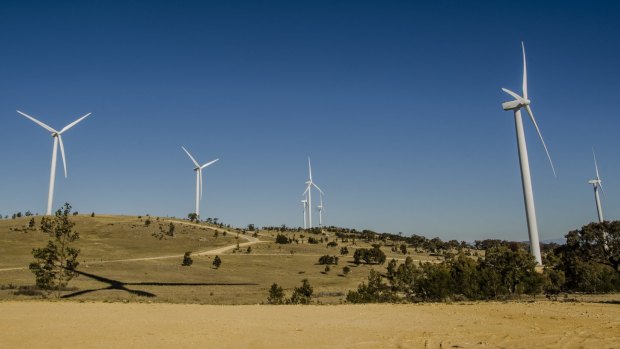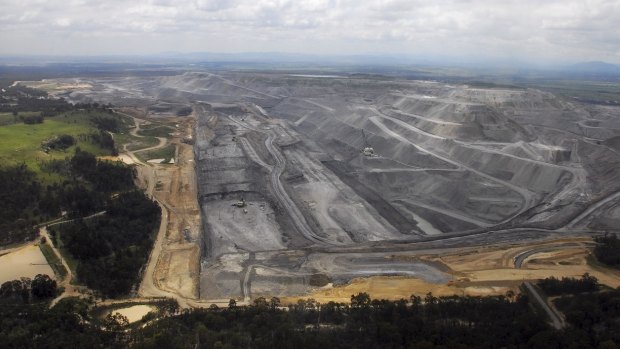This was published 8 years ago
Billions lined up for renewable energy in NSW as mining's outlook dims
By Peter Hannam
Renewable-energy backers are prepared to pour as much as $13 billion into new projects in NSW, helping the state cope with declines in coal and other mining industries.
While coal remains the state's dominant source of electricity, wind, solar and other clean-energy projects "are increasing their footprint as technology becomes more sophisticated", Energy Minister Anthony Roberts told the start of a two-day biennial investment conference in Sydney on Monday.

Wind power is increasing its footprint.Credit: Jamila Toderas
"At the moment there are 2900 megawatts of renewable-energy projects with development approval in NSW," Mr Roberts said. "They have the potential to inject nearly $6 billion into the state's economy."
Potential projects involving another 5400 megawatts are also being planned that, if realised in full, would swell the investment tally by another $6 billion to $7 billion.

New coal-fired plants are out of favour.
Mr Roberts' comments come as the federal government attacked Labor's goal – endorsed by the ALP national conference at the weekend – of nearly tripling the present share of renewable energy in the power sector to 50 per cent by 2030.
Prime Minister Tony Abbott told a media conference in Sydney the 50 per cent plan would involve "a massive bill, perhaps $60 billion or more". Labor dismissed the estimate as 'unscientific'.
No new coal-fired plants
Hugh Saddler, principal consultant with Pitt & Sherry, said NSW had just over 600 megawatts of existing wind farms with about 100 megawatts of large-scale solar in operation. Favourable weather resulted in record national wind generation last weekend, he said.
The prospects for new renewable energy hinge on governments maintaining an attractive investment climate, Dr Saddler said.
While the investment required to reach 50 per cent renewables is yet to be costed, he noted consumers had had to pick up a $40 billion-plus tab for upgrading the networks on the National Electricity Market alone in the most recent five-year plan.
Governments also had to assume there was an "extremely low chance" of new coal-fired power plants because investors would have to weigh the impact of some future price for their carbon emissions.
New gas-fired power stations were also unlikely in the near term, given high gas prices and a surplus of existing peaking capacity, Dr Saddler said.
"We're living on borrowed time so far as generating capacity is concerned," he said. "There's a growing investment risk for coal-fired power plants."
A spokesman for Mr Roberts confirmed "there are no coal-fired power plants planned or likely in the foreseeable future", although there are some "small-scale gas-fired plants" proposed.
Smaller than Apple
Mr Roberts' comments marked a sombre start to the investment conference, with several speakers noting the dramatic fall in the fortunes of the mining sector in recent years, particularly coal.
Marc Upcroft, a partner with PricewaterhouseCoopers, said the sell-off in shares of mining companies meant that "quite embarrassingly" the top 40 global miners – including BHP Billiton – had halved in value during the past four years.
The biggest 40 mining firms are now worth less than the single most valuable company, Apple, which as of Friday had a market capitalisation of $US710 billion ($975 billion).
Return on capital employed, an industry gauge, fell to a record low globally of 9 per cent in 2014 and continues to be well below the 15-20 per cent level considered to be the minimum hurdle rate major companies require before making new investments, Mr Upcroft said, citing data for PwC's Global Mine 2015 report.
"As an industry, we are definitely seen as being out of favour compared with the rest," Mr Upcroft said.
Impairment expenses for asset write-downs have soared to $138 billion during the past four years alone, and new spending on mining will fall further in 2015, extending last year's retreat, he said.
The top 40 mining companies cut exploration spending to just 3 per cent of last year's revenues. "That's a worrying sign. I don't think these companies would represent the best explorers globally but I know how little money the rest of the sector has to spend on exploration," Mr Upcroft said.
Several speakers also complained that NSW had become a less attractive target for mining investment because of lengthy planning delays and shifting investment rules.
"The biggest issue for us ... is just consistency of policy," said Reinhold Schmidt, chief executive of Yancoal. "And knowing that when you've started a project and that by the time you've done all your working, in four or five years' time, and you've ticked all the boxes, that the rules haven't changed halfway through."